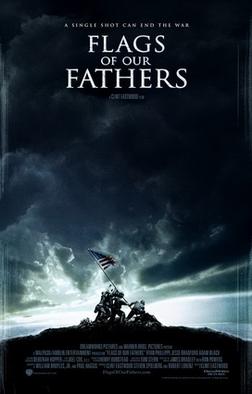The picture itself is one of the most iconic, instantly recognizable images in American history. Days into the battle for Iwo Jima, photographer Joe Rosenthal snapped a picture of six Marines on Mount Suribachi as they raised a flag pole on this remote Japanese-held island. For a country who needed it as World War II raged on and the casualty lists increased day-by-day, the picture became something bigger, something more. The story itself though, isn't so well known, as told in 2006's Flags of Our Fathers.
It's February 1945 and World War II is in its final year. The Allies are advancing on all fronts and in the Pacific theater, a huge invasion is being planned on the island of Iwo Jima. After days of horrific fighting, a platoon of Marines walks up Mount Suribachi, planting an American flag at the summit. A photographer snaps a picture that becomes an instant sensation across the U.S. Three soldiers in the picture, John Bradley (Ryan Phillippe), a Navy corpsman, and two Marines, Rene Gagnon (Jesse Bradford), and Ira Hayes (Adam Beach), are pulled from the fighting and sent back to the U.S.. Why? The trio of soldiers begin a nationwide tour so Americans buy war bonds to aid the fighting. As they criss-cross the country, each of them begins to question what they're doing. There's more to the story than what people are being told. And why are they being honored when so many others didn't make it off Iwo Jima, off hundreds of little islands all over the Pacific?
What director Clint Eastwood set out to do when he decided to make two films about the battle for Iwo Jima was truly daunting. Filming back-to-back, Eastwood filmed 'Flags' (from the American perspective) and then Letters from Iwo Jima (from the Japanese perspective). Both films received excellent reviews (Letters higher than Flags) and the two films combined to earn about $130 million in theaters while also picking up quite a few award wins and nominations. For 'Flags' alone, he's taking on a lot. The true story of the flag-raising in Iwo is a fascinating one. The picture we all know, the Marines memorial in Washington D.C., that was actually the second flag-raising on Mount Suribachi that day in March 1945. That's one of the biggest selling points for Eastwood's film, a not so well known historical story, and what actually played out. Interesting stuff throughout.
This is not a combat heavy movie for those expecting Saving Private Ryan or We Were Soldiers. This is a war story that involves combat but uses that as a jumping off point. The firefights on Iwo Jima were filmed in Iceland and are incredibly uncomfortable to watch, but that's what the fighting on Iwo was like. The Japanese garrison had miles of tunnels, bunkers, pillboxes and intended crossfires, all waiting to unleash hell. That garrison didn't intend to surrender. They intended to die fighting for the island, and the fighting was the definition of hell. These scenes aren't prolonged, but it's quick, hard-hitting and visceral. It's never flashy either. Eastwood just presents it and lets the scenes breathe. The actual flag-raising on Mt. Suribachi is almost secondary, an effective scene that is even underused a little.
No, not a combat movie. This is a movie about the profound impact the Iwo Jima picture makes in the months following the picture's release. The focus is on Phillippe, Bradford and Beach, three different responses, three solid performances. Also look for John Benjamin Hickey as Keyes Beech, the trio's military handler on the bonds tour, and John Slattery as Bud Gerber, the Treasury official working as the ramrod of the tour. The story in a sense is familiar, those who survived honored as heroes and struggling with the title. They survived while thousands of others didn't. Now they're talking heads, public relations figures meant to give the war a heroic and financial boost. A truly interesting story that isn't hugely well known.
Who else to look out for? Beyond those three main soldiers, look for Jamie Bell, Barry Pepper and Paul Walker as key Marines, Bell given more to do as a close friend of Phillippe's Bradley. Pepper is solid -- as he always is -- as Sgt. Mike Strank, the platoon sergeant trying to get his men through the fighting. Robert Patrick and Neal McDonough have small parts as higher-ranking Marines. With this comes a pretty major issue for me. The focus is almost solely on the three survivors. The Marines who raised the first flag and the three who don't survive from the second flag-raising are barely mentioned, much less introduced. When we see them killed later in a quick montage, the deaths have little to no impact because we simply don't know these young men. Two deaths do resonate, one happening off-screen, but it's because we've met these two men and know a little something about them.
The storytelling device is tricky here, 'Flags' going a little down the Saving Private Ryan route. The story is told with a modern framing device, WWII/Iwo Jima vets telling their story to a reporter ('Flags' author James Bradley). Then we're thrown back to the actual tour. Then we're thrown back to the fighting. It leaves a disjointed feel to the story without a rhythm being found. It feels like we're bouncing around too much. Mostly though, the film works. The emotions are there, and it is an effective, fascinating story. The final scene is especially touching as are the pictures we see rolling over the credits of the real-life people and the real-life incidents. It's not Saving Private Ryan, but that's an all-time classic. Well worth checking out for history and WWII buffs.
Flags of Our Fathers (2006): ***/****


No comments:
Post a Comment